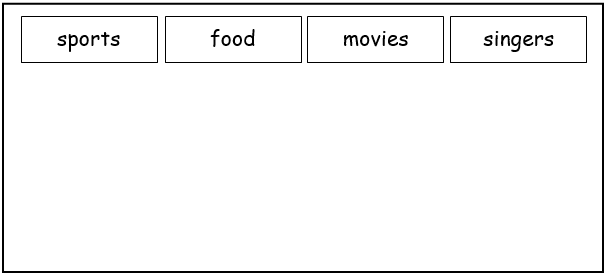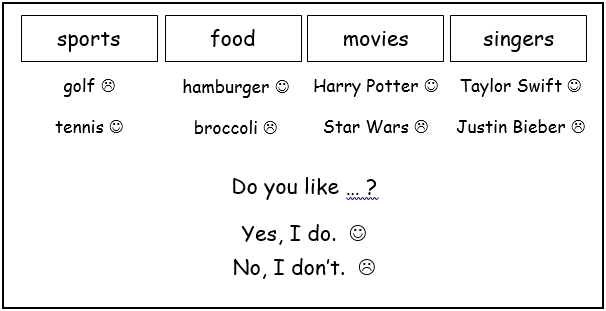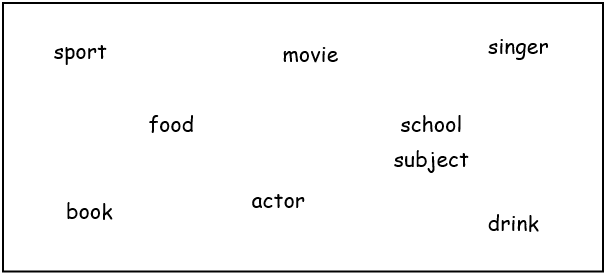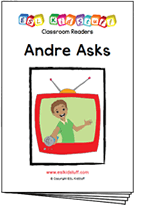Menu
Download the accompanying materials to this lesson plan - sign up here
Resources and materials for ESL Kids teachers
We can use “favorite” and “least favorite” to say the things we like and dislike the most:
We can also ask for opinions using “favorite” with Wh questions:
This lesson allows students to talk about their favorite and least favorite things. Students are then asked why they like/dislike these things and their answers include adjectives.
Make sure you have already taught likes & dislikes before teaching this lesson.
*The British English spelling is "favourite".
See our "Warm Up & Wrap Up" page.
1. Review likes and dislikes
We’ll start off with a quick review and game based on likes and dislikes, a topic which you should have already covered in a previous lesson.
On the board write 4 categories, as follows:

Elicit one example for each category from your class (e.g. sport – golf) and write it under the category. Try to pick out some items you like and dislike.
Next, elicit the question "Do you like …?" and the answers "Yes, I do" and "No, I don’t". Write them on the board. Then get the students to ask you if you like each of the four items. Answer and draw a happy or sad face next to each item to show that you like or dislike each one.
Finally, ask a student to come to the board. Have students shout out four more items to write out under the categories. Have students ask this student "Do you like …?" for each item and have the student answer and draw a happy / sad face next to each one. Your board should then look something like this:

Feel free to have other students come to the board and do for them if you think the class needs the practice.
2. Play the "Likes & Dislikes Category game"
Before class, print out enough card sets (see end of this lesson plan) for each group of 3-4 students. Cut them out and shuffle.
Put students into groups of 3-4 around a table and put the cards face-down in the middle of their table. Model with one group so everyone can see how to play the game.
Student A picks up a card and reads the category to the rest of the group (e.g. "sport"). The other students race to slap the table – the first one can say a sport (e.g. "baseball"). Student A then asks "Do you like baseball? " and the student must reply (e.g. "Yes, I do"). That student then gets to read out the next card.
The game should be fast paced and fun. When students have finished let them play again if they enjoyed it.
3. Teach "favorite / least favorite"
Wipe the board clean. From the class, elicit 8 categories from the previous card game and write them on different parts of the board, so each part of the board has a category. Something like this:

Next, crumple up a piece of paper into a ball. Stand a few paces from the board and throw it at the board. The category that the ball hits (or goes nearest to) is the one you are going to talk about. Start by giving some examples of that category, e.g.
"Food. Hmm. Hamburgers … pizza … cabbage …"
Then smile and say "But … my favorite food is ice cream!" (show by smiling and smacking your lips).
Next, go around the class asking what everyone’s favorite food is.
Then, pull a sad face and say "My least favorite food is cabbage" (show by pulling a disgusted face). Go around the class asking what everyone’s least favorite food is.
On the board write the following:
What / Who is your (least) favorite …?
My (least) favorite … is …
Get a student to volunteer and throw a ball at the board. Then ask "What/Who is your favorite …?" and "What/Who is your least favorite …?" and have the student reply using the structures on the board. For example:
Teacher: (the student’s ball has hit "singer") Who is your favorite singer?
Student: My favorite singer is Justin Bieber.
Teacher: Good! And who is your least favorite singer?
Student: My least favorite singer is Madonna.
Finally, pair up students, and get everyone to come up to the board – each pair needs a crumpled up paper ball. Pairs take turns throwing the ball and asking/answering questions about their favorites. If you have a lot of students this might be a bit chaotic with balls flying all over the place, but it will be fun!
4. Start the "Favorites Questionnaire" worksheet
Get everyone to sit down and give out the worksheet. Ask everyone to fill in the columns for "favorite" and "least favorite" for themselves (in the "YOU" column). If some students don’t have a favorite or least favorite for some items they can leave them blank.
Next, draw everyone’s attention to the "why favorite " and "why least favorite" columns. In the example for food, the adjectives "delicious" and "horrible" have been added. Chorus these words and show meaning through your actions. Ask a few students if they agree with the examples in the worksheet (pizza is delicious and cabbage is horrible).
Finally, show that there are more options for saying "why" at the bottom of the worksheet. We’ll now look more closely at these options in the next worksheet.
5. Do the "Why? adjectives" worksheet
Give out the worksheet and chorus each adjective. As you go through each one give an example and ask the students if the word is positive (+) or negative (-). For example:
Teacher: Delicious … Ok, pizza is delicious! Mmmm, yummy! Is ‘delicious’ positive or negative?
Students: Positive!
Teacher: Yes, that’s right! What other food is delicious?
Students: Cake, hotdogs, tacos, etc.
As you go through the adjectives, students mark the positive or negative on their worksheets.
Next, put students in pairs and have them match the categories to the adjectives. Multiple answers are possible here – at the end go through all of the answers and give examples where necessary.
6. Play "Guess the adjective"
Put students in groups of 3 or 4. Start by modeling the activity – choose one of the adjectives from the worksheet and act it out – for example, act out eating pizza and smacking your lips. Students can shout out which adjective they thinking you are acting (e.g. delicious for pizza).
Then in groups, students take it in turns to act out an adjective. Finally, ask some groups to act out their best ones to the whole class.
7. Continue with the "Favorites Questionnaire" worksheet
Have students sit back down and take out their first worksheets. Give 5 minutes to fill in their own "why favorite" and "why least favorite? " columns. Students can add one or two adjectives for each item. Whilst they are doing this, circulate and check that students are putting correct adjectives in the columns.
When everyone has finished, pair up students. Students can interview each other to complete their worksheets. Before starting, model with a student, as follows:
Teacher: Ok Saki, what is your favorite food?
Student: It’s pasta.
Teacher: Oh really? Why is pasta your favorite food?
Student: Because it’s delicious!
Then have students interview each other. Circulate as they are doing this and help out with mistakes and pronunciation. Finally, ask each pair to stand up and do one of their items in front of the class.
8. Read classroom reader "Andre Asks"
This story practices the structures from today’s lesson. Before class, download and print off the reader "Andre Asks". As you go through each page, point to the pictures in the thought bubbles and elicit what each person might be thinking about. Also, ask lots of questions to students to see what their favorites are, for example:
 Teacher: (pointing at the picture on page 2) What is this?
Teacher: (pointing at the picture on page 2) What is this?
Students: Pasta? Spaghetti?
Teacher: It’s spaghetti! Let’s see what they say. (reading) “Hi! What’s your favorite food?“ “It’s spaghetti.“ “Really? Why is it your favorite?“ “Because it’s delicious!”. Do you like spaghetti, Miguel?
Student: Yes, I do!
Teacher: Is spaghetti your favorite food?
Student: No. My favorite food is fried chicken.
Teacher: Really? Why?
Student: Because it’s delicious.
Teacher: Good job! How about you, Clara? Do you like spaghetti?
etc.
Get the students really involved in the story by asking lots of questions about the what their favorites and least favorites are.
As you read through the story, write the phrases on the board that Andre uses to show interest. At the end you should have the following phrases on the board:
You’ll use these in the final activity.
After reading the story, give out a reader worksheet to each student and read through the story one more time (without stopping for questions, etc.) as students complete the table. Then go through the answers as a class.
---
Alternatively, watch our video version of the reader (Internet connection required):
9. Do "TV interviews"
In this final activity, students are going to reenact the story from the classroom reader. Put students in groups of 4-6. Have each group elect the TV show interviewer. The other students in the group will answer the questions. If you have any toy microphones, they are a great prop to give out for the TV interviews. You can even make some out of cardboard.
Give the groups 5 minutes to practice their skit – they can choose which categories they will ask about (even new ones!) – they should aim to ask for around 8-10 preferences.
As the students prepare, encourage the interviewer to do the following:
Finally, have each group come up to the front of the class and put on their TV show. Do not interrupt, even if there are mistakes. At the end give a round of applause, give lots of praise and then explain any corrections.
1. Assign Homework: "Family Favorites Questionnaire" worksheet (explain that they have to interview 2 members of their family, e.g. mother, father, brother, sister, etc.).
2. Wrap up the lesson with some ideas from our "Warm Up & Wrap Up" page.
 Found a mistake?
Found a mistake?
Please let us know
Full access to all resources on ESL KidStuff including lesson plans, flashcards, worksheets, craft sheets,
song downloads, classroom readers, flashcards app and songs app.